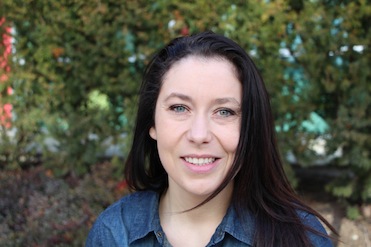Kacie Auffret, Masters Student, University of British Columbia Okanagan
Presentation Summary
A Moment of Si(l)ence
My artwork takes a critical view on the human and “nonhuman” relationship. I examine how animals are seen as tools or resources to be used by humans and, more specifically, how the “nonhuman” is used for food, clothing, or research purposes. My work seeks to draw the audience in with the subject matter through the strategic use of video installation, photographs, performance art, and printmaking. A question that I pose through the installation, A Moment of Si(l)ence, is, how would an ecofeminist artist address the theme of what ecofeminist Lori Gruen calls “entangled empathy”? (Strangers to nature: animal lives and human ethics) What Gruen, a philosopher and critical animal studies scholar, means is that:
“[e]ntangled empathy is a process whereby individuals who are empathizing with others first respond to the other’s condition (most likely but not exclusively, by way of a precognitive empathetic reaction) (Strangers to nature: animal lives and human ethics).
My goal in A Moment of Si(l)ence is to foster a conscious experience of entangled empathy through the installation by encouraging the viewer to acknowledge all the suffering and death of nonhumans that takes place in laboratories throughout Canada. My hope is each viewer will feel compassion for the nonhumans that suffered either before they entered the gallery space or once they have left.
A Moment of Si(l)ence seeks to create a moment for the viewer(s) to recognize how many deaths of animals occur within laboratories. The installation’s purpose is to allow the viewer to take a moment out of their day to reflect upon the lives that were taken in the name of science. There are many who believe that animals do not feel pain, sadness, joy, or compassion and thereby claim it is not necessary to extend the same ethical concern to them as is given to humans; however, humans still argue we need the nonhumans to be used in science because it is the thought that the needs of humans are more significant than that of animals. As ethical philosopher Peter Singer says,
The researcher’s central dilemma exists in an especially acute form in psychology: either the animal is not like us, in which case there is no reason for performing the experiment; or else the animal is like us, in which case we ought not to perform on the animal an experiment that would be considered outrageous if performed on one of us. (Animal Liberation)
Singer’s above statement brings into view challenging questions: if the nonhuman is nothing like the human then why do we need to test on them? And, if we argue that the nonhuman is like the human with emotions and feelings and being the subject of a life, then what gives us the right to test on them?
A Moment of Si(l)ence focuses on the relationship between the human and nonhuman in the context of the experiments that took place in Canada in the year of 2010. Perhaps we need to know, I asked, what it is that takes place behind closed doors of science laboratories. :
In 2010, a total of 211,604 animals were involved in scientific research at UBC. This represents roughly 6 per cent of total animals involved in research in Canada (3.375 million according to the Canadian Council for Animal Care.)(Animal Research at UBC)
Bio
Kacie Auffret graduated with a BFA honours from the University of Windsor and is now pursing her MFA in Visual Arts interdisciplinary creative and critical studies at the University of British Columbia Okanagan. Auffret’s work ranges from intaglio printmaking, digital media, photographs and performance art. Auffret’s interested in the relationships between people and animals, including animals in the industrial food chain, wildlife, household pets, and lab specimens. Auffret is now researching the difference between hunted animals and factory farming.

